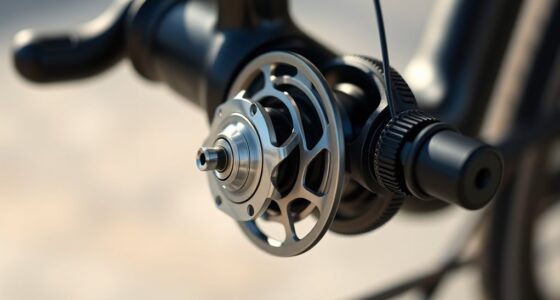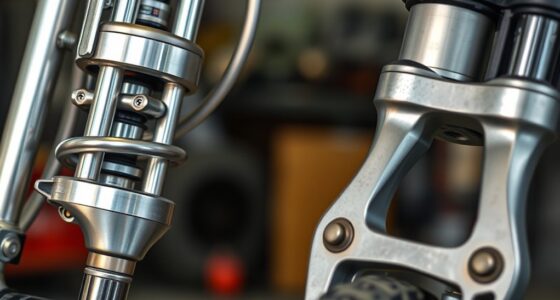Choosing the right gear ratio depends on your riding style and terrain. Use lower gears for steep climbs to ease pedaling, and higher gears for flat surfaces and speed. Regularly maintain your bike by cleaning and checking the derailleur to guarantee smooth shifts. Practice shifting techniques by easing off pedals and shifting gradually. Proper gear selection enhances performance, comfort, and longevity—keeping you confident on every ride. Keep exploring to discover how to find the perfect setup for you.
Key Takeaways
- Assess your riding terrain and style to determine if lower ratios (hills) or higher ratios (speed) suit you.
- Consider the gear ratio’s impact on pedaling efficiency and energy conservation.
- Match gear ratios to your cycling discipline, such as mountain biking or road racing.
- Regularly maintain and lubricate components to ensure smooth gear shifting and optimal performance.
- Practice proper shifting techniques to prevent gear slipping and maintain a seamless riding experience.

Gear ratios are fundamental to understanding how your vehicle transfers power from the engine to the wheels. Whether you’re riding a bike or driving a car, your choice of gear ratios impacts performance, efficiency, and riding comfort. When it comes to bikes, mastering bike maintenance and gear shifting techniques will help you make the most of your gear ratios. The right gear ratio allows you to optimize your pedaling efficiency, conserve energy, and tackle different terrains with ease.
Selecting the appropriate gear ratios depends on your riding style and terrain. If you’re tackling steep hills, you’ll want a lower gear ratio, which makes pedaling easier but sacrifices some speed. Conversely, for flat terrains or high-speed riding, higher gear ratios help you maintain momentum and reach top speeds more comfortably. Regular bike maintenance is vital because it ensures your gears shift smoothly and reliably. Clean and lubricate your chain, inspect your derailleur, and replace worn components to prevent slipping or skipping gears during rides. Well-maintained gears give you precise control over gear shifting techniques, making transitions between gears seamless and reducing strain on your knees and legs.
Understanding how to shift gears properly enhances your riding experience and prolongs your bike’s lifespan. When shifting, avoid forcing the lever or shifting under heavy load, as this can cause damage. Instead, ease off the pedals slightly, shift smoothly, and wait for the gears to engage fully before resuming your pedaling. Practicing these gear shifting techniques helps you develop a natural sense of when to shift, whether you’re accelerating, climbing, or descending. Over time, you’ll learn to anticipate terrain changes and adjust gears proactively, making your ride more efficient and enjoyable.
Your choice of gear ratios also affects how you approach different cycling disciplines. For example, mountain biking requires low, versatile ratios for technical climbs and quick shifts to handle varied terrain. Road cycling favors higher ratios for speed and efficiency on flat surfaces. Additionally, understanding gear ratio mechanics and how they interact with your bike’s components can help you optimize your setup for performance and durability. By understanding the mechanics behind gear ratios and practicing good bike maintenance, you can customize your gearing setup to match your riding goals. This not only improves your performance but also reduces unnecessary wear and tear on your bike components.
In essence, mastering gear ratios involves more than just selecting the right gears; it’s about understanding how they interact with your riding conditions and developing smooth, confident gear shifting techniques. Regular bike maintenance keeps your gears functioning properly, which makes shifting easier and more precise. When you combine this knowledge with attentive riding, you’ll enjoy a smoother ride and get the most out of your bike’s capabilities.
Frequently Asked Questions
How Do Gear Ratios Affect Acceleration and Top Speed?
A lower gear ratio boosts your acceleration dynamics, making your vehicle respond quicker off the line, but it limits your top speed. Conversely, a higher gear ratio allows for higher top speeds but slows down acceleration. You should choose your gear ratio based on whether you prioritize rapid acceleration or maximum speed, balancing these factors according to your driving needs and terrain.
Can Changing Gear Ratios Improve Fuel Efficiency?
Ever wondered if tweaking your gear ratios can boost your fuel economy? Absolutely. By optimizing your gear setup, you reduce engine strain and improve efficiency, especially at cruising speeds. Changing gear ratios allows you to match your vehicle’s performance to your driving style, leading to better fuel economy. Gear optimization minimizes unnecessary engine work, conserves fuel, and keeps your drive smooth, making every drop count.
Are There Different Gear Ratio Options for Electric Bikes?
Yes, electric bikes offer different gear ratio options, allowing you to optimize performance and efficiency. When bike maintenance, regularly check your gear shifting techniques to guarantee smooth transitions and prevent wear. Experiment with different gear ratios to find what suits your riding style best, especially on varied terrains. Properly maintaining your gears and mastering gear shifting techniques will help you get the most out of your electric bike’s range and overall ride quality.
How Do Gear Ratios Influence Off-Road Riding Performance?
Gear ratios directly impact your off-road riding by affecting your torque and speed. With gear ratio customization, you can optimize your bike for steep climbs or fast descents, making rides smoother and more efficient. Keep in mind, different gear ratios may require extra maintenance considerations, like checking chain tension and wear more frequently. Adjusting your gear ratios allows you to tailor your bike’s performance to challenging terrains, enhancing control and reducing fatigue.
What Gear Ratios Are Best for Towing Heavy Loads?
Think of your truck as a strong horse pulling a heavy cart. For towing heavy loads, choose lower gear ratios to maximize torque, helping you handle trailer weight with ease. Make certain your gear ratio matches your trailer weight and brake compatibility, so your vehicle won’t strain or overheat. This setup gives you the power and control needed to tow safely and efficiently, even when the load gets heavy.
Conclusion
Understanding gear ratios helps you optimize your ride for any terrain. Did you know that choosing the right gearing can improve your efficiency by up to 30%? By tailoring your gears, you’ll enjoy smoother climbs and faster descents. Remember, experimenting with different ratios lets you find what works best for your riding style. So go ahead, tweak your gears, and experience the difference—your ride will thank you!








